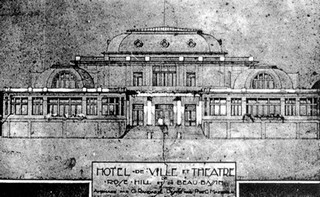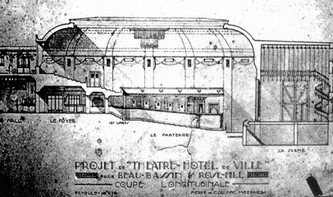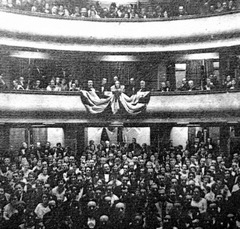 Whoever goes through Rose-Hill, Mauritius second town, cannot but admire its four most beautiful monuments which, lying within the same perimeter,
form a quadrilateral exceptional in beauty and history. Indeed; this space comprises the catholic church of Notre Dame de Lourdes erected in 1890,
the Mauritian Montmartre chapel dating back to 1940, the wide and ancient colonial house known as la Maison Carné and the municipal building which includes
the Plaza theatre.
Whoever goes through Rose-Hill, Mauritius second town, cannot but admire its four most beautiful monuments which, lying within the same perimeter,
form a quadrilateral exceptional in beauty and history. Indeed; this space comprises the catholic church of Notre Dame de Lourdes erected in 1890,
the Mauritian Montmartre chapel dating back to 1940, the wide and ancient colonial house known as la Maison Carné and the municipal building which includes
the Plaza theatre.
The Plaza theatre forms part of a municipal complex that the local authorities decided to erect in 1927 following, amongst other reasons, a petition
from the inhabitants requesting the construction of « a theatre worthy of the growing importance » of the locality. In those days, only one place could accommodate
the companies that used to come each year to Mauritius with operas or operettas, namely the Port-Louis theatre. Consequently, when performing out of the capital city,
the companies could not do otherwise but accept the rather narrow stages of unsuitable cinema halls. At the same time, being given the ongoing development of the town,
the local authorities were eager to have a permanent headquarters and space for offices.
A national competition led to the choice of the present structure, i. e. three bodies, surrounded by stone-built stairs, linked but independent one from the other
and with one aisle for municipal offices, another one with a wide hall where balls or banquets could be organized, the main central body being devoted to the theatre hall.


From the very start, the project - ambitious in the whole – is still more ambitious as regards the theatre to be built and the fact is that it is still nowadays
one of the most beautiful and of the widest in the south-west of the Indian Ocean. Built in the Italian style and enjoying, thus, appreciable acoustics,
it can host up to 1500 spectators with its 54 boxes, its 450 first class seats, its 422 second class seats, its 426 third class seats and its standing gallery
for 100 more spectators.
The stage zone (a turning stage since the 1980s) for the artists and the stagehands is as wide as the spectator’s zone and makes it possible to maximize the show
both in depth and in height. Thanks to the expert advice of a French producer Louis Tharaud who was then living in Rose Hill, important building errors
regarding the stage have been avoided!

|
The intention was to have an opera or an operetta – directed by the expert Louis Tharaud – to launch the building which took 5 years to be completed.
But financial realities did not meet the dreams! The inauguration hosted a musical comedy but in the form of a film! Inspired by Oscar Straus’s A waltz dream,
this comedy entitled The smiling lieutenant had been realized in 1932 with prestigious actors: the unequalled Maurice Chevalier, the exuberant Myriam Hopkins
and the so charming Claudette Colbert! |
The first company to perform on the Plaza stage was, finally, as soon as 1934, a local company, the Mauritius Dramatic Club, playing in English plays
from the English-speaking repertoire with Shakespearian dramas, comedies and/or detective stories...
Very soon, were performed various live shows in different languages – though French and English were the most frequent: classical plays, dramas, comedies, operettas,
operas, variety theatre, ballets, traditional dances (in particular, Indian), festivals, bodybuilding shows, fashion shows, magic shows, conferences …
Those shows were not only proposed by foreign companies, but also and often by local groups. And, in parallel with the film projections which never stopped
since the opening of the theatre gathering the amateurs, the three bangs preceding the opening of the traditional red curtain were regularly waited for by the audience.
The first Mauritian plays to be produced were, in the 1950s, Mirages and Iscariote by Arthur Martial, then La Verrue by André Masson
and Judas by Malcolm de Chazal in 1960.
As years went by, a high level expertise developed behind the stage. Under the direction of a decor director, Serge Constantin, also a painter, trained in the best London and Paris art schools, stagehand, light specialists and decorators contributed to the enchantment of the spectators.
This text is inspired by G. André Decotter’s book entitled Le Plaza : un demi-siècle de vie théâtrale